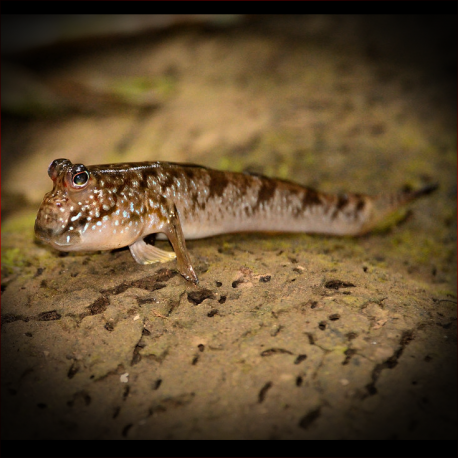More info
Datasheet
| Minimum Tank Size | 150 litres / 39.63 US gallons |
| Maximum Size | 15.0cm / 5.91inches |
| Temperature | 25°C / 77.00°F - 30°C / 86.00°F |
| Hardness | 10-25ºdH |
| pH | 7.0-8.5 |
General Description
The Periophthalmus Barbarus, also known as the Atlantic Mudskipper, is a fascinating species due to its highly amphibious nature. These creatures exhibit unique behaviors such as sitting in shallows with bodies submerged, eyes protruding above the surface, or resting exposed on rocks. They possess high-set eyes for 360° vision, engaging in curious interactions with their surroundings and quickly recognizing familiar faces, especially during feeding times. Being territorial creatures, they display flagging behavior for warnings and can resort to physical aggression, making them best suited for species tanks to prevent conflicts.
Aquarium Setup
For housing Periophthalmus Barbarus, a tank setup with exposed land areas like sand banks or mudflats is essential. Providing humid conditions matching water temperature is crucial, along with a secure lid to prevent escape. Brackish conditions are preferred, achieved by adding marine salt to reach a specific gravity around 1.005. Plants tolerant to brackish waters such as mangroves or Java fern are recommended, along with efficient filtration due to their messy nature.
Behaviour
These mudskippers are highly territorial with conspecifics, requiring ample space to prevent aggressive encounters. In captivity, they display territorial actions, including flagging behavior and territorial disputes, especially among dominant males. Their unique locomotion methods like "crutching" and "skipping" contribute to their captivating behavior, showcasing their adaptability to both water and land environments.
Feeding and Diet
Feeding on a diet of crabs, insects, invertebrates, and various live or frozen foods, the Atlantic Mudskipper is adaptable in captivity. Offering a diet consisting of live supplements like worms, crickets, flies, and frozen foods ensures their nutritional needs are met. Avoiding dried foods that may cause bloating is advised, with a preference for a varied diet to maintain their health.
Reproduction & Dimorphism
Although challenging to breed in captivity, in the wild, male Periophthalmus Barbarus constructs deep mud burrows for mating and brood care. Sexual dimorphism becomes apparent during spawning seasons, with males displaying brighter colors and more aggressive behaviors. Females guard the offspring post-hatching, showcasing distinct behaviors that aid in sexing these mudskippers.
Habitat and Distribution
Naturally found in estuarine mangrove swamps along the West African coastline, from Mauritania to Angola, the Atlantic Mudskipper thrives in mudflats at the water's edge. Exhibiting complex behaviors and adaptations enabling them to respire atmospherically, these fish are hardy and captivating additions to aquaria, reflecting their intriguing habitats and distributions.

